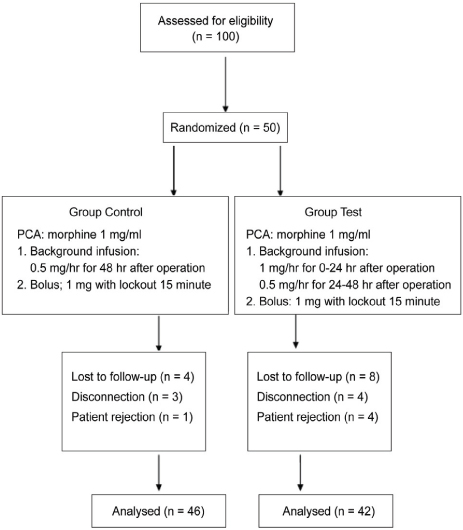J Dent Anesth Pain Med.
2016 Dec;16(4):289-294. 10.17245/jdapm.2016.16.4.289.
The evaluation of implementing smart patient controlled analgesic pump with a different infusion rate for different time duration on postoperative pain management
- Affiliations
-
- 1Department of Anesthesiology and Pain Medicine, School of Medicine, Kyungpook National University, Daegu, Korea.
- 2Department of Anesthesiology and Pain Medicine, School of Dentistry, Kyungpook National University, Daegu, Korea. jeon68@knu.ac.kr
- KMID: 2366157
- DOI: http://doi.org/10.17245/jdapm.2016.16.4.289
Abstract
- BACKGROUND
Control of postoperative pain is an important aspect of postoperative patient management. Among the methods of postoperative pain control, patient-controlled analgesia (PCA) has been the most commonly used. This study tested the convenience and safety of a PCA method in which the dose adjusted according to time.
METHODS
This study included 100 patients who had previously undergone orthognathic surgery, discectomy, or total hip arthroplasty, and wished to control their postoperative pain through PCA. In the test group (n = 50), the rate of infusion was changed over time, while in the control group (n = 50), drugs were administered at a fixed rate. Patients' pain scores on the visual analogue scale, number of rescue analgesic infusions, side effects, and patients' satisfaction with analgesia were compared between the two groups.
RESULTS
The patients and controls were matched for age, gender, height, weight, and body mass index. No significant difference in the mount of drug administered was found between the test and control groups at 0-24 h after the operation; however, a significant difference was observed at 24-48 h after the operation between the two groups. No difference was found in the postoperative pain score, number of side effects, and patient satisfaction between the two groups.
CONCLUSIONS
Patient-controlled anesthesia administered at changing rates of infusion has similar numbers of side effects as infusion performed at a fixed rate; however, the former allows for efficient and safe management of postoperative pain even in small doses.
Keyword
MeSH Terms
Figure
Reference
-
1. Gepstein R, Arinzon Z, Folman Y, Shuval I, Shabat S. Efficacy and complications of patient-controlled analgesia treatment after spinal surgery. Surg Neurol. 2007; 67:360–366.
Article2. Kehlet H. Fast-track colorectal surgery. Lancet. 2008; 371:791–793.
Article3. Palmer PP, Miller RD. Current and developing methods of patient-controlled analgesia. Anesthesiol Clin. 2010; 28:587–599.
Article4. Rowbotham DJ. The development and safe use of patient-controlled analgesia. Br J Anaesth. 1992; 68:331–332.
Article5. Butkovic D, Kralik S, Matolic M, Kralik M, Toljan S, Radesic L. Postoperative analgesia with intravenous fentanyl PCA vs epidural block after thoracoscopic pectus excavatum repair in children. Br J Anaesth. 2007; 98:677–681.
Article6. Choi SH, Koo BN, Nam SH, Lee SJ, Kim KJ, Kil HK, et al. Comparison of remifentanil and fentanyl for postoperative pain control after abdominal hysterectomy. Yonsei Med J. 2008; 49:204–210.
Article7. Shin S, Min KT, Shin YS, Joo HM, Yoo YC. Finding the ‘ideal’ regimen for fentanyl-based intravenous patient-controlled analgesia: how to give and what to mix. Yonsei Med J. 2014; 55:800–806.
Article8. Cartwright P, Prys-Roberts C, Gill K, Dye A, Stafford M, Gray A. Ventilatory depression related to plasma fentanyl concentrations during and after anesthesia in humans. Anesth Analg. 1983; 62:966–974.
Article9. Kim JY, Park SY, Chang HS, Nam SK, Min SK. The efficacy of the time-scheduled decremental continuous infusion of fentanyl for postoperative patient-controlled analgesia after total intravenous anesthesia. Korean J Anesthesiol. 2013; 65:544–551.
Article10. Tran M, Ciarkowski S, Wagner D, Stevenson JG. A case study on the safety impact of implementing smart patient-controlled analgesic pumps at a tertiary care academic medical center. Jt Comm J Qual Patient Saf. 2012; 38:112–119.
Article11. Conti G, Costa R, Pellegrini A, Craba A, Cavaliere F. Analgesia in PACU: intravenous opioids. Curr Drug Targets. 2005; 6:767–771.
Article12. Grass JA. Patient-controlled analgesia. Anesth Analg. 2005; 101:S44–S61.
Article13. Kim JJ, Ha MH, Jung SH, Song NW. The efficiency of IV PCA with remifentanil and ketorolac after laparoscopic-assisted vaginal hysterectomy. Korean J Anesthesiol. 2011; 61:42–49.
Article14. Shibutani K, Inchiosa MA, Sawada K, Bairamian M. Pharmacokinetic mass of fentanyl for postoperative analgesia in lean and obese patients. Br J Anaesth. 2005; 95:377–383.
Article15. Kovac AL, Eberhart L, Kotarski J, Clerici G, Apfel C. A randomized, double-blind study to evaluate the efficacy and safety of three different doses of palonosetron versus placebo in preventing postoperative nausea and vomiting over a 72-hour period. Anesth Analg. 2008; 107:439–444.
Article16. Lui F, Ng KF. Adjuvant analgesics in acute pain. Expert Opin Pharmacother. 2011; 12:363–385.
Article17. Kehlet H, Werner M, Perkins F. Balanced analgesia: what is it and what are its advantages in postoperative pain. Drugs. 1999; 58:793–797.
- Full Text Links
- Actions
-
Cited
- CITED
-
- Close
- Share
- Similar articles
-
- Clinical Application of Gas Forming Infusion Pump for Intravenous Postoperative Pain Control
- Performance evaluation study of a commercially available smart patient-controlled analgesia pump with the microbalance method and an infusion analyzer
- Smart syringe pumps for drug infusion during dental intravenous sedation
- Comparative Efficacy of Mechanical Patient-Controlled Analgesia Pump Operated in Patient Optimizing Background Infusion Mode and Conventional Nonmechanical Pump after Laparoscopic Surgery
- A new therapeutic option for postoperative pain management with oxycodone HCI injection


